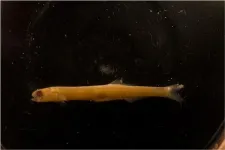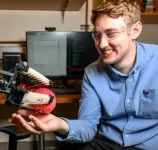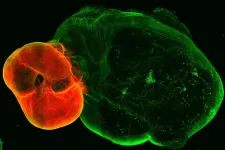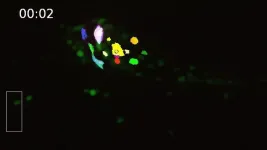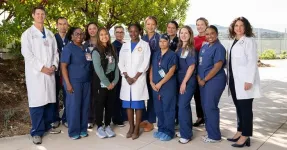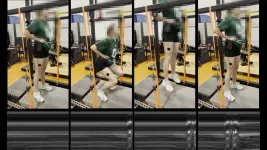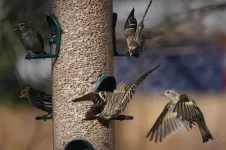(Press-News.org) New research from Scripps and NOAA scientists has discovered ecological correlations that could help explain the booms and busts of California’s anchovy population. If the correlations hold up to further research, they could one day help inform management of California’s anchovy fishery and improve conservation.
The Northern Anchovy (Engraulis mordax) is a crucial food source for much of California’s most conspicuous marine life – including droves of sea lions, pods of dolphins, lucrative tuna fisheries, and throngs of whales. But one of the hallmarks of the anchovy population off California is the cycle of booms and busts that can last for more than a decade. These ups and downs reverberate through the entire marine ecosystem, with busts at times contributing to starving sea lion pups or leading brown pelicans to abandon their chicks.
Exactly what drives these booms and busts has remained elusive despite decades of scientific study, notably by the CalCOFI research program which is cooperatively run by UC San Diego’s Scripps Institution of Oceanography, the National Oceanic and Atmospheric Administration (NOAA), and the California Department of Fish and Wildlife. The program surveys marine ecosystems up and down the California coast and is one of the largest and longest ocean monitoring programs in the world.
The study, published December 5 in Nature Communications and funded by NOAA and the National Science Foundation, points to the marine ecosystem surrounding newly hatched anchovies known as larvae. The researchers analyzed 45 years-worth of anchovy larvae collected during CalCOFI surveys and found that the length of the food chain supporting the larvae strongly correlates with anchovy population booms and busts. Specifically, shorter food chains preceded booms and longer ones preceded busts. Shorter larval food chains have fewer steps of one animal eating another between the photosynthetic phytoplankton harvesting the sun’s energy at the base of the food chain and the larvae, which eat mostly zooplankton.
Rasmus Swalethorp, the study’s lead author and an associate project scientist at Scripps, said one of the likely explanations for this correlation is that shorter food chains are more efficient and result in more energy from the base of the food chain reaching the anchovy larvae. Swalethorp said this is because each time organisms from different parts of the food chain consume each other there is a loss of energy that is known to occur.
“It’s analogous to the energy loss that occurs when electricity goes from the power plant to our homes – the longer the distance, the more energy gets lost along the way,” said Swalethorp. “That’s how it is going from one level of a food chain to the next – the more steps, the less energy gets to the anchovy larvae. The larvae could be eating the exact same foods but when the food chain elongates it may mean food is less plentiful or that the same foods don’t contain as much energy.”
As a result, a shorter food chain can likely support more individual anchovy larvae.
Swalethorp began the research behind this paper in 2014, hoping to use the strength of CalCOFI’s sampling program to better understand the mechanisms underpinning the rises and falls of this crucial player in the California Current Ecosystem.
“The ocean is a very big place and our ability to sample it in a way that’s representative is very limited,” said Swalethorp. “CalCOFI is the most comprehensive ocean ecosystem survey on the planet and it’s the best shot we have at getting at these bigger ecological mechanisms.”
Specifically, the researchers wanted to test the idea that a key determinant of how many Northern Anchovy survive the dangers of larval life in a given year is the structure of the food chain those larvae participate in. To do this, the researchers used stable nitrogen isotope analysis to determine food chain length for 207 roughly three-week-old anchovy larvae collected by the CalCOFI program between 1960 and 2005.
In 2020, the team published a paper detailing this method of estimating food chain length in chemically preserved fish, which rests on the basic idea that when one organism eats another, the consumed creature leaves a chemical signature in the tissues of its consumer. In this case, the analysis doesn’t reveal the precise identity of who was eating whom but could be used to infer how many links were in the food chain between the phytoplankton and the anchovy larvae.
The analysis revealed that shorter larval food chains tended to precede periods of booming anchovy populations by a year or two, and longer larval food chains were associated with depressed anchovy numbers in the following one to two years. Additionally, the changes in food chain length persisted throughout most of the boom and bust phases.
As for how and why food chain length might increase or decrease from year to year, Swalethorp offered some potential explanations.
“Young anchovy larvae are very susceptible to starvation, and their survival really depends on the efficiency by which energy reaches them,” said Swalethorp. “If the food chain is short and efficient, that likely helps more larvae survive, which can help drive a boom cycle in the next year or two.”
Because the current study can’t identify the individual species in the longer and shorter food chains it found, Swalethorp said the study can’t explain why longer food chains correlate to anchovy busts and vice versa. Regardless of why this correlation exists, Swalethorp said a larval food chain index – a yearly measurement of larval food chain length using stable nitrogen isotopes – could potentially be a useful tool for estimating anchovy population trends in the near future, but that more research is needed to explore its potential.
Swalethorp also noted that while larval food chain length appears to have been an important driver during the studied period, other important drivers exist and their relative importance likely varies over space and time.
In the future, Swalethorp said extending the study’s time series to the present would be fascinating, because the current analysis does not cover the years following 2015 when anchovy populations once again boomed off California. He also said the team is beginning to probe the complex questions of who exactly is eating whom when the food chains elongate as well as what is triggering these changes at the base of the food chain.
Beyond this, the true test of this correlation’s explanatory power will be when the researchers attempt to apply it to other regions and other species of fish such as the Peruvian anchoveta (Engraulis ringens) – the single largest fishery in the world.
The study was co-authored by Michael Landry, Brice Semmens, Mark Ohman, and Lihini Aluwihare of Scripps as well as Dereka Chargualaf and Andrew Thompson of NOAA Fisheries Service, and in collaboration with the CCE-LTER program.
END
Study proposes new explanation for California anchovy booms and busts
Despite the ecological and economic importance of anchovy off California, their population’s characteristic rises and falls have remained mysterious for decades
2023-12-05
ELSE PRESS RELEASES FROM THIS DATE:
A new publication in Nature Communications can revolutionize the treatment of Parkinson's patients
2023-12-05
The results are just published in Nature Communications under the title "Enhanced production of mesencephalic dopaminergic neurons from lineage-restricted human undifferentiated stem cells."
In the new research findings, DANDRITE group leader and Associate Professor Mark Denham has developed a method that ensures much higher purity of the so-called dopamine cells, which are crucial in connection with Parkinson's disease.
"Stem cells offer promising potential for treating Parkinson's disease by transforming into specific nerve cells. However, the precision of this transformation poses a significant challenge with current methods, resulting in low purity," ...
Eye scans provide crucial insights into kidney health, study finds
2023-12-05
3D eye scans can reveal vital clues about kidney health that could help to track the progression of disease, research suggests.
The advance could revolutionise monitoring of kidney disease, which often progresses without symptoms in the early stages.
Experts say the technology has potential to support early diagnosis as current screening tests cannot detect the condition until half of the kidney function has been lost.
Researchers used highly-magnified images to detect changes to the retina – the layer of tissue at the back of the eye that senses light and sends signals to the ...
Diamonds and rust help unveil ‘impossible’ quasi-particles
2023-12-05
Researchers have discovered magnetic monopoles – isolated magnetic charges – in a material closely related to rust, a result that could be used to power greener and faster computing technologies.
Researchers led by the University of Cambridge used a technique known as diamond quantum sensing to observe swirling textures and faint magnetic signals on the surface of hematite, a type of iron oxide.
The researchers observed that magnetic monopoles in hematite emerge through the collective behaviour of many spins (the angular momentum of a particle). These monopoles glide across the swirling textures on the surface of the hematite, like tiny ...
Unlocking the secrets of the brain’s dopaminergic system
2023-12-05
A new organoid model of the dopaminergic system sheds lights on its intricate functionality and potential implications for Parkinson’s disease. The model, developed by the group of Jürgen Knoblich at the Institute of Molecular Biotechnology (IMBA) of the Austrian Academy of Sciences, replicates the dopaminergic system’s structure, connectivity, and functionality. The study, published on December 5 in Nature Methods, also uncovers the enduring effects of chronic cocaine exposure on the dopaminergic circuit, even after withdrawal.
A completed run, the early morning hit of caffeine, the smell of cookies in the oven - these ...
Enhanced AI tracks neurons in moving animals
2023-12-05
Recent advances allow imaging of neurons inside freely moving animals. However, to decode circuit activity, these imaged neurons must be computationally identified and tracked. This becomes particularly challenging when the brain itself moves and deforms inside an organism’s flexible body, e.g. in a worm. Until now, the scientific community has lacked the tools to address the problem.
Now, a team of scientists from EPFL and Harvard have developed a pioneering AI method to track neurons inside moving and deforming animals. The study, now published ...
UC San Diego Health recognized as leader in high quality OB/GYN care
2023-12-05
UC San Diego Health is recognized as a 2023-2024 High Performing Hospital for Maternity Care, which is the highest award a hospital can earn by U.S. News & World Report for obstetric and infant care.
To be recognized as High Performing in Maternity Care, hospitals must meet high standards in caring for patients with uncomplicated pregnancies, such as low cesarean section rates, low newborn complication rates, offering transparency on racial and ethnic disparities, and other measures.
“It is an honor to receive this prominent recognition, ...
Mental health crisis highlights access challenges
2023-12-05
The ongoing mental health crisis is causing significant challenges for many psychologists as they grapple with demand fueled by patients presenting with increasingly severe symptoms year after year, according to APA’s 2023 Practitioner Pulse Survey.
The survey, which was completed by 561 licensed practicing psychologists between Aug. 30 and Sept. 29, 2023, found that not only did more than half of psychologists (52%) say that they were seeing an increase in severity of symptoms among their patients, but 41% said that they were seeing ...
Wearable ultrasound monitor can aid rehabilitation from injury #Acoustics23
2023-12-05
SYDNEY, Dec. 5, 2023 – Millions suffer from musculoskeletal injuries every year, and the recovery process can often be long and difficult. Patients typically undergo rehabilitation, slowly rebuilding muscle strength as their injuries heal. Medical professionals routinely evaluate a patient’s progress via a series of tasks and exercises. However, because of the dynamic nature of these exercises, obtaining a clear picture of real-time muscle function is extremely challenging.
Parag Chitnis of George Mason University led a team that developed a wearable ultrasound system that can produce clinically relevant information about muscle function during dynamic physical activity. He ...
Bird feeding may give humans something to chirp about
2023-12-05
Ashley Dayer hopes to peck away at the notion that bird feeding is simply for the birds.
Associate professor in the Department of Fish and Wildlife Conservation at Virginia Tech, Dayer is the lead author of an article published in People and Nature that argues not only for the acknowledgment of the activity’s benefit to humans, but that it should play a role in public guidance and policy.
“Wildlife agencies and others making decisions on managing bird feeding need to be considering not only what the science is behind what’s going on with birds, but also the science behind what’s going on with people,” ...
Using AI to find microplastics
2023-12-05
An interdisciplinary research team from the University of Waterloo is using artificial intelligence (AI) to identify microplastics faster and more accurately than ever before.
Microplastics are commonly found in food and are dangerous pollutants that cause severe environmental damage – finding them is the key to getting rid of them.
The research team’s advanced imaging identification system could help wastewater treatment plants and food production industries make informed decisions ...
LAST 30 PRESS RELEASES:
Jeonbuk National University researchers develop novel dual-chemical looping method for efficient ammonia synthesis
New study sheds light on stroke recovery via exercise-induced migration of mitochondria
SEOULTECH researchers develop sodium-based next-generation smart electrochromic windows
Data-driven analysis reveals three archetypes of armed conflicts
Heart disease, stroke deaths down, yet still kill more in US than any other cause
Light switches made of ultra-thin semiconductor layers
Creative talent: has AI knocked humans out?
Sculpting complex, 3D nanostructures with a focused ion beam
A year after undermining Bredt’s rule, UCLA scientists have made cage-shaped, double-bonded molecules that defy expectations
Human activities drive global dryland greening
PeroCycle announces new appointments as it builds a world-class board for meaningful climate impact
Magnetic avalanches power solar flares
LeapSpace goes live: the Research-Grade AI-Assisted Workspace built on trusted science
DNA tests reveal mysterious beluga family trees
Strategic sex: Alaska’s beluga whales swap mates for long-term survival
How early cell membranes may have shaped the origins of life
Cannabis legalization is driving increases in marijuana use among U.S. adults with historically lower consumption rates
Multifunctional dipoles enabling enhanced ionic and electronic transport for high‑energy batteries
Triboelectric nanogenerators for future space missions
Advancing energy development with MBene: Chemical mechanism, AI, and applications in energy storage and harvesting
Heteroatom‑coordinated Fe–N4 catalysts for enhanced oxygen reduction in alkaline seawater zinc‑air batteries
Meta-device for precision lateral displacement sensing
Plasma-guided mitotane for the treatment of adrenocortical carcinoma: adjuvant care to advanced disease
Theoretical study of laser-enhanced nuclear fusion reactions
Social environment impacts sleep quality
Optimized kinetic pathways of active hydrogen generation at Cu2O/Cu heterojunction interfaces to enhance nitrate electroreduction to ammonia
New design playbook could unlock next generation high energy lithium ion batteries
Drones reveal how feral horse units keep boundaries
New AI tool removes bottleneck in animal movement analysis
Bubble netting knowledge spread by immigrant humpback whales
[Press-News.org] Study proposes new explanation for California anchovy booms and bustsDespite the ecological and economic importance of anchovy off California, their population’s characteristic rises and falls have remained mysterious for decades
